The Smart Water Monitoring Market is estimated to be valued at USD 18.4 billion in 2025 and is projected to reach USD 67.6 billion by 2035, registering a compound annual growth rate (CAGR) of 13.9% over the forecast period.
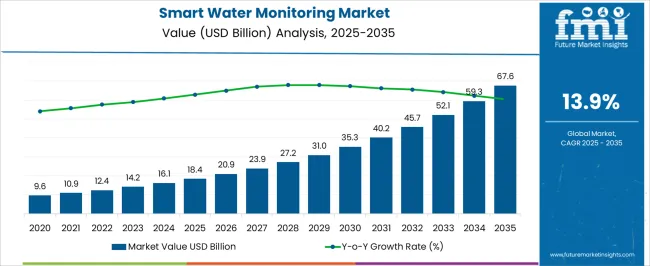
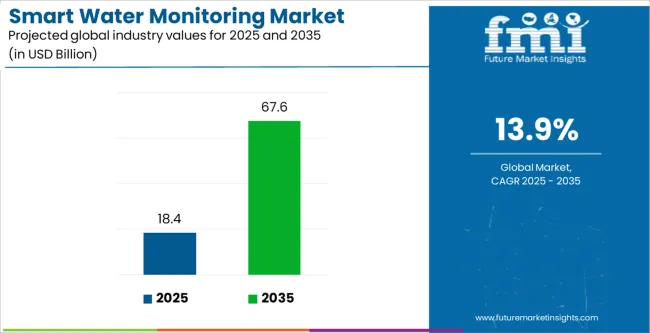
| Metric | Value |
|---|---|
| Smart Water Monitoring Market Estimated Value in (2025 E) | USD 18.4 billion |
| Smart Water Monitoring Market Forecast Value in (2035 F) | USD 67.6 billion |
| Forecast CAGR (2025 to 2035) | 13.9% |
The Smart Water Monitoring market is advancing rapidly as industries and municipalities prioritize water efficiency, regulatory compliance, and sustainability goals. Growing concerns over water scarcity and the pressing need to reduce losses across distribution networks have accelerated the deployment of intelligent monitoring systems. The current market landscape is characterized by an increased focus on integrating IoT, cloud computing, and data analytics into water management systems, allowing stakeholders to track consumption patterns, detect leaks in real time, and optimize distribution.
Rising government initiatives for sustainable water use and investments in smart city infrastructure are further enhancing adoption. The future outlook suggests strong growth momentum, as utilities and industries alike are expected to embrace digital technologies for resource optimization.
With water conservation gaining prominence in both developed and emerging regions, the market is positioned to benefit from long-term demand The ability of smart monitoring systems to deliver cost savings, improve decision-making, and ensure regulatory adherence is creating significant opportunities for continued expansion across sectors.
The smart water monitoring market is segmented by type, component, end user, and geographic regions. By type, smart water monitoring market is divided into Quantitative Monitoring and Qualitative Monitoring. In terms of component, smart water monitoring market is classified into Hardware, Software, and Services. Based on end user, smart water monitoring market is segmented into Industrial, Residential, Commercial, and Corporate. Regionally, the smart water monitoring industry is classified into North America, Latin America, Western Europe, Eastern Europe, Balkan & Baltic Countries, Russia & Belarus, Central Asia, East Asia, South Asia & Pacific, and the Middle East & Africa.
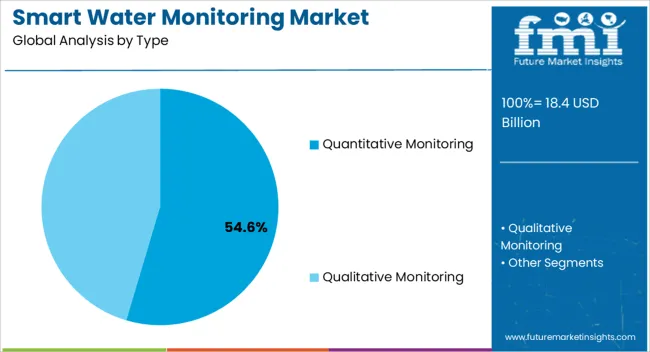
The quantitative monitoring type is projected to account for 54.60% of the Smart Water Monitoring market revenue in 2025, making it the leading segment. This dominance is being attributed to the rising importance of accurate and real-time measurement of water usage, which is essential for both industrial and municipal applications.
Quantitative monitoring allows utilities and enterprises to track consumption patterns, identify inefficiencies, and take corrective actions based on data-driven insights. The growth of this segment has been reinforced by the increasing use of IoT-enabled sensors and meters that transmit continuous data, enabling faster detection of anomalies such as leaks and unauthorized consumption.
As water scarcity continues to intensify, the ability to measure and manage every drop has become critical, further boosting demand for quantitative monitoring solutions Additionally, stricter regulatory frameworks and sustainability goals across multiple regions have created pressure on industries and municipalities to adopt advanced monitoring systems that can deliver transparency and accountability in water management practices.
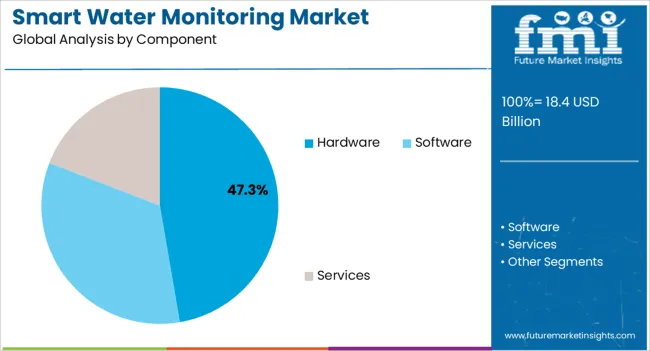
The hardware component is expected to capture 47.30% of the overall Smart Water Monitoring market revenue in 2025, emerging as the dominant component segment. This leadership is being driven by the critical role that physical devices such as sensors, meters, transmitters, and data loggers play in collecting accurate water-related information. Hardware adoption has been accelerated by advancements in low-power devices and miniaturized sensors, which have enabled cost-effective deployments at scale.
The growing demand for robust and durable monitoring devices capable of withstanding harsh environmental conditions has further supported this segment’s expansion. Hardware remains a fundamental enabler of smart monitoring systems, as reliable data collection is the first step toward analytics and decision-making.
Moreover, the rapid modernization of water infrastructure, particularly in industrial and urban utilities, has required large-scale installations of smart meters and flow sensors With demand for real-time water management rising, hardware continues to hold a strong position, supported by ongoing innovation in device efficiency and network connectivity.
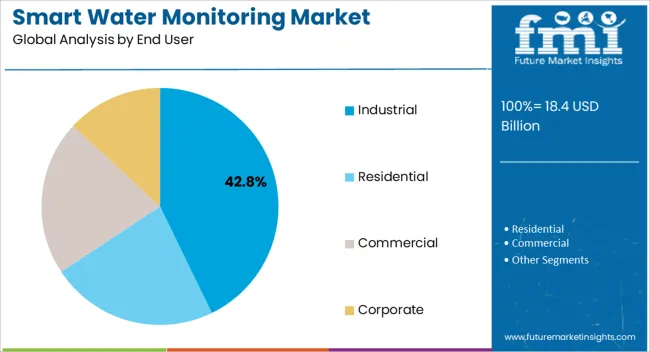
The industrial end-user segment is anticipated to hold 42.80% of the Smart Water Monitoring market revenue in 2025, making it the largest contributor by end use. This dominance is being driven by the high water consumption levels across industries such as manufacturing, energy, mining, and food and beverages, which necessitate precise monitoring and management. Industrial users are increasingly adopting smart water monitoring solutions to ensure regulatory compliance, reduce operational costs, and optimize water usage in production processes.
The ability of these systems to detect leaks, manage wastewater, and provide detailed consumption analytics has strengthened their appeal in industrial operations. Rising environmental regulations have also compelled industries to adopt sustainable practices, further boosting adoption of smart monitoring technologies.
With growing emphasis on corporate sustainability and operational efficiency, industries are investing in advanced systems that not only conserve water but also enhance productivity This segment’s leadership is expected to persist as industries continue to face increasing scrutiny over their environmental footprint and resource management practices.
Water has always been a crucial part of our lives, and due to pollution and contamination this critical element in terms of safe drinking water is replenishing. Nowadays, due to global warming, water quality and quantity monitoring in real time has become a challenge, and the growing population is left with limited water resources. Hence, there is a critical need for developing better methodologies for smart water monitoring (quality and quantity parameters) in real time. Smart Water Monitoring is such a solution which facilitates the monitoring of water quality, and helps in providing safe water to the population across globe. Smart Water Monitoring market is expected to have a potential growth during the forecast period, because of the daily requirement for control of quality and quantity through smart water monitoring techniques in future years. Smart Water Monitoring is not only limited to large water plants and water utilities, but is also used at residential and corporate levels. Moreover, the focus towards conserving water provides better opportunities to Smart Water Monitoring market. And practice of purifying the water before its usage is growing, which in turn is driving the market for Smart Water Monitoring in the forecast period. With such an increasing inclination towards using safe water, the market for Smart Water Monitoring solutions is expected to have substantial growth opportunity over the forecast period promoting the growth of Smart Water Monitoring Market.
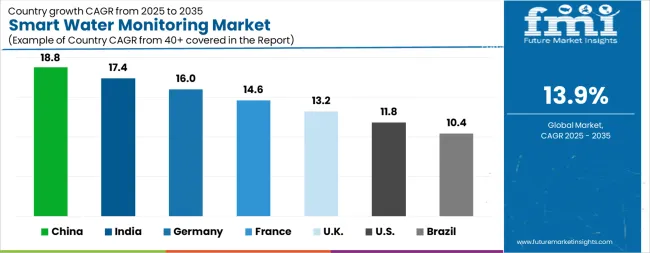
| Country | CAGR |
|---|---|
| China | 18.8% |
| India | 17.4% |
| Germany | 16.0% |
| France | 14.6% |
| UK | 13.2% |
| USA | 11.8% |
| Brazil | 10.4% |
| China | 7.0% |
| India | 6.5% |
| Germany | 6.0% |
| France | 5.5% |
| UK | 4.9% |
| USA | 4.4% |
| Brazil | 3.9% |
The Smart Water Monitoring Market is expected to register a CAGR of 13.9% during the forecast period, exhibiting varied country level momentum. China leads with the highest CAGR of 18.8%, followed by India at 17.4%. Developed markets such as Germany, France, and the UK continue to expand steadily, while the USA is likely to grow at consistent rates. Brazil posts the lowest CAGR at 3.9%, yet still underscores a broadly positive trajectory for the global Smart Water Monitoring Market. In 2024, Germany held a dominant revenue in the Western Europe market and is expected to grow with a CAGR of 16.0%. The USA Smart Water Monitoring Market is estimated to be valued at USD 6.7 billion in 2025 and is anticipated to reach a valuation of USD 20.6 billion by 2035. Sales are projected to rise at a CAGR of 11.8% over the forecast period between 2025 and 2035. While Japan and South Korea markets are estimated to be valued at USD 941.9 million and USD 584.1 million respectively in 2025.
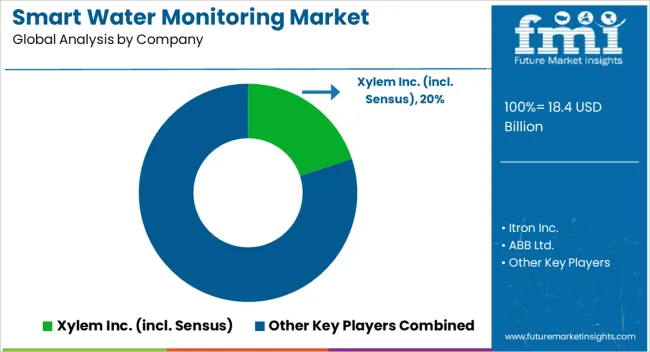
| Item | Value |
|---|---|
| Quantitative Units | USD 18.4 Billion |
| Type | Quantitative Monitoring and Qualitative Monitoring |
| Component | Hardware, Software, and Services |
| End User | Industrial, Residential, Commercial, and Corporate |
| Regions Covered | North America, Europe, Asia-Pacific, Latin America, Middle East & Africa |
| Country Covered | United States, Canada, Germany, France, United Kingdom, China, Japan, India, Brazil, South Africa |
| Key Companies Profiled | Xylem Inc. (incl. Sensus), Itron Inc., ABB Ltd., ABB Ltd., and Schneider Electric SE (+AVEVA) |
The global smart water monitoring market is estimated to be valued at USD 18.4 billion in 2025.
The market size for the smart water monitoring market is projected to reach USD 67.6 billion by 2035.
The smart water monitoring market is expected to grow at a 13.9% CAGR between 2025 and 2035.
The key product types in smart water monitoring market are quantitative monitoring and qualitative monitoring.
In terms of component, hardware segment to command 47.3% share in the smart water monitoring market in 2025.






Our Research Products

The "Full Research Suite" delivers actionable market intel, deep dives on markets or technologies, so clients act faster, cut risk, and unlock growth.

The Leaderboard benchmarks and ranks top vendors, classifying them as Established Leaders, Leading Challengers, or Disruptors & Challengers.

Locates where complements amplify value and substitutes erode it, forecasting net impact by horizon

We deliver granular, decision-grade intel: market sizing, 5-year forecasts, pricing, adoption, usage, revenue, and operational KPIs—plus competitor tracking, regulation, and value chains—across 60 countries broadly.

Spot the shifts before they hit your P&L. We track inflection points, adoption curves, pricing moves, and ecosystem plays to show where demand is heading, why it is changing, and what to do next across high-growth markets and disruptive tech

Real-time reads of user behavior. We track shifting priorities, perceptions of today’s and next-gen services, and provider experience, then pace how fast tech moves from trial to adoption, blending buyer, consumer, and channel inputs with social signals (#WhySwitch, #UX).

Partner with our analyst team to build a custom report designed around your business priorities. From analysing market trends to assessing competitors or crafting bespoke datasets, we tailor insights to your needs.
Supplier Intelligence
Discovery & Profiling
Capacity & Footprint
Performance & Risk
Compliance & Governance
Commercial Readiness
Who Supplies Whom
Scorecards & Shortlists
Playbooks & Docs
Category Intelligence
Definition & Scope
Demand & Use Cases
Cost Drivers
Market Structure
Supply Chain Map
Trade & Policy
Operating Norms
Deliverables
Buyer Intelligence
Account Basics
Spend & Scope
Procurement Model
Vendor Requirements
Terms & Policies
Entry Strategy
Pain Points & Triggers
Outputs
Pricing Analysis
Benchmarks
Trends
Should-Cost
Indexation
Landed Cost
Commercial Terms
Deliverables
Brand Analysis
Positioning & Value Prop
Share & Presence
Customer Evidence
Go-to-Market
Digital & Reputation
Compliance & Trust
KPIs & Gaps
Outputs
Full Research Suite comprises of:
Market outlook & trends analysis
Interviews & case studies
Strategic recommendations
Vendor profiles & capabilities analysis
5-year forecasts
8 regions and 60+ country-level data splits
Market segment data splits
12 months of continuous data updates
DELIVERED AS:
PDF EXCEL ONLINE
Smart Water Management Market Size and Share Forecast Outlook 2025 to 2035
Smart Water Metering Market Size and Share Forecast Outlook 2025 to 2035
Smart Water Grid Market Growth - Trends & Forecast 2025 to 2035
Smart Water Bottle Market Size & Growth 2024 to 2034
Smart Pest Monitoring Management System Market Size and Share Forecast Outlook 2025 to 2035
Smart Home Water Sensors & Controllers Market Trends & Forecast 2025 to 2035
Smart Welding Monitoring Solution Market Analysis - Size, Share, and Forecast Outlook 2025 to 2035
Water Level & Storage Monitoring Software Market
Commercial Smart Water Meter Market Size and Share Forecast Outlook 2025 to 2035
Residential Smart Water Metering Market Size and Share Forecast Outlook 2025 to 2035
Smart Meeting Pod Market Size and Share Forecast Outlook 2025 to 2035
Smart Electrogastrogram Recorder Market Size and Share Forecast Outlook 2025 to 2035
Smart Aerial Work Robots Market Size and Share Forecast Outlook 2025 to 2035
Smart Bladder Scanner Market Size and Share Forecast Outlook 2025 to 2035
Smart School Bus Platform Market Size and Share Forecast Outlook 2025 to 2035
Smart Home Wireless Smoke Detector Market Size and Share Forecast Outlook 2025 to 2035
Smart Bus Platform Market Size and Share Forecast Outlook 2025 to 2035
Smart Vision Processing Chips Market Size and Share Forecast Outlook 2025 to 2035
Smart Touch Screen Scale Market Size and Share Forecast Outlook 2025 to 2035
Water Vapor Permeability Analyzers Market Size and Share Forecast Outlook 2025 to 2035

Thank you!
You will receive an email from our Business Development Manager. Please be sure to check your SPAM/JUNK folder too.
Chat With
MaRIA